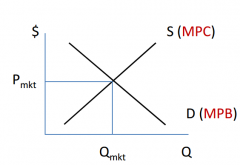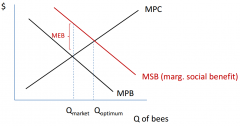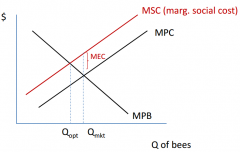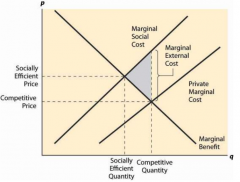![]()
![]()
![]()
Use LEFT and RIGHT arrow keys to navigate between flashcards;
Use UP and DOWN arrow keys to flip the card;
H to show hint;
A reads text to speech;
30 Cards in this Set
- Front
- Back
|
Externalities
|
an external cost or benefit of an activity to tho
se not directly involved in the activity |
|
|
Positive externalities examples:
|
• Research & Development
• Education • Immunisation of children • Proper disposal of rubbish • Bees pollinating crops |
|
|
Negative externalities examples:
|
• Pollution (air, water, noise)
• Traffic congestion • Smoking, drinking |
|

How externalities affect resource allocation...
|
the bee-keeper adds hives until the added revenue she gets (marginal private benefit) from the last hive equals the cost of adding it (marginal private cost).
MPB = MPC |
|
|
Positive consumption externality:
hives are neighbouring an orchard. |

Note: MSB = MPB + MEB
(where MEB is the marg. external benefit) |
|
|
Negative production externality:
hives are neighbouring a school. |

Note: MSC = MPC + MEC
|
|
|
The invisible hand
|

An individual pursuit of self-interest which does not result in the largest possible economic surplus.
The result is market failure. |
|
|
Private solutions to externalities
|
• Moral codes
• Charities • Scholarships and prizes • Business integration |
|
|
The Coase Theorem
|
If private parties can bargain without transaction costs, they can solve the problem of externalities on their own. Because of the reciprocal nature of the problem.
|
|
|
Coase Theorem assumptions:
|
1. clearly defined and enforced property rights
2. full information and non-strategic behaviour 3. zero transactions costs |
|
|
Coase Theorem; real world issues
|
• Lack of rationality whilst bargaining..
• What if there are 20 ranchers? (there will be transactions costs, risk of strategic behaviour, asymmetric information, coordination problems, etc.) •Income effect between an individual and a producer (WTP of an individual farmer ≠ WTA of a wealthy rancher) |
|
|
Public policies on externalities
|
1. Command-and-control policies: regulation
2. Market-based policies 1: corrective taxes 3. Market based policies 2: tradable pollution permits |
|
|
Corrective taxes
|
a tax enacted to correct the effects of a negative externality
|
|
|
Trade-able Pollution Permits
|
• Governments sets an overall pollution cap.
• Firms can trade these permits: → the more costly it is for firms to cut back on pollution, the more likely they are to buy permits. → those firms that can reduce pollution most heaply, will do so and sell permits => the external cost of production is internalised. |
|
|
NZ wants to create a full scale ETS that includes a
ll sectors and all greenhouse gases (GHGs) Three key principles for emissions trading in NZ: |
1. Low cost to NZ Inc.
2. No individuals should suffer disproportionately large personal losses. 3. Robust – credible, feasible, durable |
|
|
Issues with an ETS (Emission Trading Scheme):
|
• Point of obligation (what entity should be responsible for reporting emissions and matching them with permits?)
• Leakage problem? • Distributional impacts? |
|
|
Private goods:
(food, clothing, toys, beers) |
Rival & excludable
|
|
|
Common property resources:
(fish, water, forests) |
Rival & Non-excludable
|
|
|
Club goods:
(satellite television, bridges) |
Non-rival & excluable
|
|
|
Pure public goods:
(radio transmissions, national defence, etc.) |
Non-rival & non-excludable
|
|
|
Exclude-able means...
Rival means... |
- access to a good is restricted, i.e. a person can be
prevented from using it. - one person’s use diminishes other people’s use. |
|
|
Free-rider problem
|
Someone who benefits from resources, goods, or services without paying for the cost of the benefit.
=> If everyone free-rides, collective benefits won’t be provided. |
|
|
1. Tragedy of Commons
|
social cost > private cost
(negative production externality) • Each herder is motivated to add more and more animals because he receives the direct benefit of his animals but bears only a share of the costs resulting from overgrazing. |
|
|
2. Prisoner’s dilemma
|

individually rational strategies lead to collectively irrational outcomes.
|
|
|
Prisoner’s dilemma - Dominant Strategy
|
The strategy that is best for a player in a game regardless of the strategies chosen by other players.
=> (Confess, Confess) : (8, 8) |
|
|
Prisoner's dilemma- Pareto Inferior
|
The best result for both parties.
=> if both had remained silent, they would have gotten 1 year. |
|

Prisoners Dilemma- Common Property Resource (CPR)
|
Cooperate strategy: L/2 animals; profit = 10 units
Defect strategy: > L/2; profits = 0 Dominant strategy results in worst outcome. |
|
|
3. Logic of collective action
|
individuals with common interest would voluntarily
act so as to try to further those interests. Olsen Argued: “unless the number of individuals is quite small, or unless there is coercion or some other special device to make individuals act in their common interest." => free-riding |
|
|
GOVT Intervention: Overcoming tragedy of commons:
|
• 'Iron Govt' - Coercive force, eg. Military preventing poaching in South Africa .
• Private ownership |
|

Modification of the Herders’ game: central Govt decides on specific herding strategy
• Govt imposes penalty of 2 profit units on anyone who defects. Assuming... |
Accurate information, perfect monitoring, sanctioning
reliability, zero admin costs, ... |

